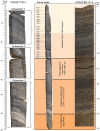High-resolution analysis of the varved succession at Crawford lake across the base of the proposed Crawfordian stage and Anthropocene series
- PMID: 40756383
- PMCID: PMC12317751
- DOI: 10.1177/20530196251315454
High-resolution analysis of the varved succession at Crawford lake across the base of the proposed Crawfordian stage and Anthropocene series
Abstract
Four years after the Anthropocene Working Group (AWG) voted to work toward defining the Anthropocene series/epoch with a base in the mid-20th C, the varved sediments of Crawford Lake (Milton, ON, Canada) were selected as the Global boundary Stratotype Section and Point (GSSP) candidate. The initial major rise in activity of 239 + 240Pu had been selected as the primary chronostratigraphic marker to define the base of the Anthropocene, but the precise year when this occurred could not be determined from measurements of samples combining multiple varves. Individual varves from freeze cores collected in April 2023 provide annual resolution for bomb radionuclides, allowing the varve age model to be refined, former assignments determined to have been 1 year too old. The increase in 239 + 240Pu activities (calculated from atom concentrations of 239Pu and 240Pu measured using Accelerated Mass Spectrometry) of 0.0031 Bq/g between varves now assigned to 1951 and 1952 is consistent with the onset of thermonuclear weapons testing on November 1, 1952, so the proposed base for the Anthropocene is at the contact between the light- and dark-coloured laminae deposited in 1952 CE (17.5 cm in core CRA23-BC-1F-B). Sharply lower 239 + 240Pu and 137Cs activities capture the moratorium from November 1958 to September 1961 before rising quickly to peak activities of 239 + 240Pu in 1963 CE. Analysis of individual varves with varying amounts of organic matter and inorganic calcite illustrates the influence of lithology on organic proxies, but the upcore trend toward depleted values of δ15N through the 20th C reflects increased fossil fuel combustion worldwide. An inflection point in δ15N around 1911 CE is attributed the global impact of the Haber-Bosch process and establishment of nearby steel mills, and another in the early 1950s attributed to the Great Acceleration to which the tipping point in the Earth system is attributed.
Keywords: GSSP; Great Acceleration; radionuclides; stable isotopes; varves.
© The Author(s) 2025.
Figures









References
-
- Anthropocene Working Group (AWG) (2024. a) Ballot form for voting on 1) the preferred core for the Crawford Lake GSSP, and 2) the preferred level for the proposed GSSP in the Crawford Lake core. Vote commencing. Available at: 10.31223/X5MQ3C (accessed 1 November 2024). - DOI
-
- Anthropocene Working Group (AWG) (2024. b) The Anthropocene Epoch and Crawfordian age: proposals by the Anthropocene Working Group Submitted to the ICS Subcommission on Quaternary Stratigraphy on. Available at: https://eartharxiv.org/repository/view/6963/ (accessed 1 November 2024).
-
- Buesseler K. (2023) The isotopic signature of fallout plutonium in the North Pacific. Journal of Environmental Radioactivity 36: 69−83.
-
- Burns DA, Aherne J, Gay DA, et al. (2016) Acid rain and its environmental effects: Recent scientific advances. Atmospheric Environment 146: 1–4.
-
- Byrne R, Finlayson WD. (1998) Iroquoian agriculture and forest clearance at Crawford Lake, Ontario. In: Finlayson WD. (ed.) Iroquoian Peoples of the Land of Rocks and Water A.D. 1000–1650: A Study in Settlement Archaeology. London, UK: Museum of Archaeology, London, Ontario, Canada: The University of Western Ontario, Special Publication, pp. 94–107.
LinkOut - more resources
Full Text Sources
Miscellaneous
